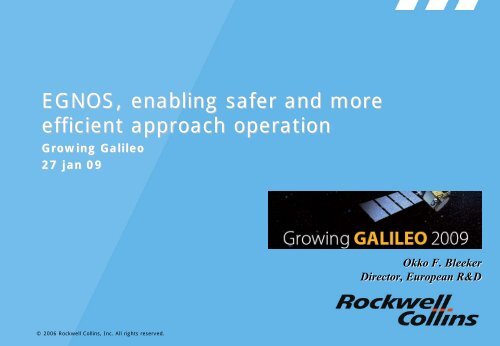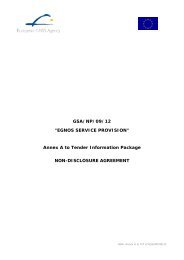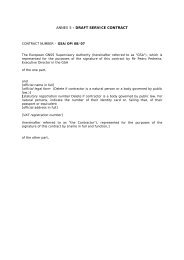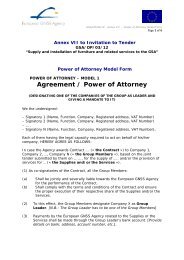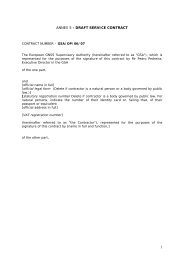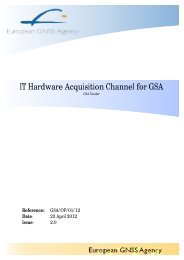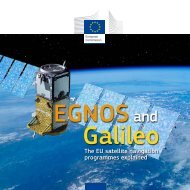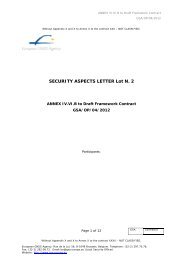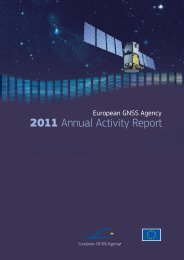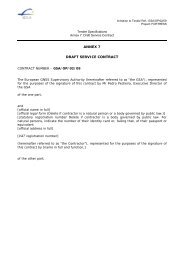EGNOS, enabling safer and more efficient flight operation
EGNOS, enabling safer and more efficient flight operation
EGNOS, enabling safer and more efficient flight operation
- No tags were found...
Create successful ePaper yourself
Turn your PDF publications into a flip-book with our unique Google optimized e-Paper software.
<strong>EGNOS</strong>, <strong>enabling</strong> <strong>safer</strong> <strong>and</strong> <strong>more</strong><br />
<strong>efficient</strong> approach <strong>operation</strong><br />
Growing Galileo<br />
27 jan 09<br />
Okko F. Bleeker<br />
Director, European R&D<br />
© 2006 Rockwell Collins, Inc. All rights reserved.
Main Flight control functions <strong>and</strong> allocations<br />
Aircraft sensors<br />
(current state vector)<br />
Reference<br />
trajectory<br />
FMS<br />
(Flt Mgmt System)<br />
Position in space<br />
Velocity Vector<br />
Attitude<br />
Δ<br />
Δ<br />
Δ<br />
Δ<br />
AFCS<br />
(Autopilot)<br />
Flight Control<br />
System<br />
(conventional<br />
or FBW)<br />
The contents of this document are proprietary to Rockwell Collins, Inc.<br />
2/22
Aircraft sensors<br />
(current state vector)<br />
Reference<br />
trajectory<br />
FMS<br />
(Flt Mgmt System)<br />
Position in space<br />
Velocity Vector<br />
Attitude<br />
Δ<br />
Δ<br />
Δ<br />
Δ<br />
AFCS<br />
(Autopilot)<br />
Flight Control<br />
System<br />
(conventional<br />
or FBW)<br />
The contents of this document are proprietary to Rockwell Collins, Inc.<br />
3/22
Reference trajectory - RT<br />
• The path that the FMS guides the aircraft to<br />
• Must be the “right” path<br />
– Inaccuracy aircraft mis-positioning (1:1)<br />
– Selecting the ‘wrong’ reference path aircraft ends up [accurately] at the<br />
wrong position<br />
• Must be of the proper resolution<br />
– A target position as wide as a football field<br />
– Will get the aircraft “accurately anywhere” inside that space<br />
• Must be properly retained <strong>and</strong> processed by the FMS<br />
– Data base pre-cautions; CRC/wrappers to enable integrity verification<br />
• Must be properly designed <strong>and</strong> constructed<br />
– To reflect the desired procedure<br />
– Incl. any obstacle clearance requirement<br />
The contents of this document are proprietary to Rockwell Collins, Inc.<br />
4/22
RNP, Baro VNAV, ultimately LPV<br />
LPV ref traj<br />
Vertical<br />
containment<br />
minimums<br />
RNP<br />
Lateral<br />
containment<br />
FACF<br />
FAF<br />
The contents of this document are proprietary to Rockwell Collins, Inc.<br />
5/22
RNP, Baro VNAV, ultimately LPV<br />
RNP<br />
LPV ref traj<br />
Vertical<br />
containment<br />
FACF<br />
Lateral<br />
containment<br />
FAF<br />
minimums<br />
Going lower<br />
Tighter required lateral<br />
containment<br />
Requiring vertical containment<br />
More solution integrity<br />
• Coupling between lateral <strong>and</strong><br />
obstacle clearance<br />
• Minimums governed by:<br />
– Best available containment<br />
– Best available solution integrity<br />
• Re: proximity to surface<br />
The contents of this document are proprietary to Rockwell Collins, Inc.<br />
6/22
LPV, vertical path definition<br />
• LPV is a geometric path projection<br />
– similar to ILS Glideslope, temperature<br />
independent<br />
– Angular Full Scale (FS) Deviation is +/- 0.25 *<br />
Glide Path Angle (GPA)<br />
– FS dev limited to +/- 500’ linear, then angular,<br />
then +/- 50’ linear<br />
Baro VNAV<br />
• Affected by temperature<br />
variations<br />
• Requires corresponding<br />
tolerances<br />
• Increases minimums<br />
The contents of this document are proprietary to Rockwell Collins, Inc.<br />
7/22
Aircraft sensors<br />
(current state vector)<br />
Reference<br />
trajectory<br />
F<br />
(Flt Mgmt Syste<br />
Position in space<br />
Velocity Vector<br />
Attitude<br />
Δ<br />
Δ<br />
Δ<br />
Δ<br />
AF<br />
(Autopi<br />
Flight Cont<br />
Syst<br />
(conventio<br />
or FB<br />
The contents of this document are proprietary to Rockwell Collins, Inc.<br />
8/22
FMS - Position estimation<br />
• GNSS position<br />
– Requires integrity to outweigh VOR, DME in the position fixing equatione<br />
The contents of this document are proprietary to Rockwell Collins, Inc.<br />
9/22
Why SBAS is important (1/3)<br />
GPS<br />
US<br />
EUMEA<br />
The contents of this document are proprietary to Rockwell Collins, Inc.<br />
10/22
Why SBAS is important (2/3)<br />
US<br />
The contents of this document are proprietary to Rockwell Collins, Inc.<br />
EUMEA<br />
• Minimum 4 pseudo<br />
ranges for a fix<br />
• >4: over-<br />
determination<br />
– 5-6: Fault Detection (FD)<br />
– 6-8: Fault Detection &<br />
Exclusion (FDE)<br />
• This scheme: RAIM<br />
– Receiver-autonomous<br />
integrity monitoring<br />
– Requires 6-86<br />
8 visible<br />
satellites<br />
– In good constellation<br />
• Requires RAIM<br />
‘forecast’<br />
– To assure FDE will be<br />
available<br />
– If not, alternative pos<br />
determination<br />
11/22
Why SBAS is important (3/3)<br />
GPS<br />
WAAS<br />
<strong>EGNOS</strong><br />
US<br />
• SBAS uplinks data on integrity <strong>and</strong> accuracy<br />
– Therefore over-determination of the fix is not needed<br />
– While providing wide area differential error correction<br />
• Result: better availability of high accuracy solution with integrity<br />
– Thus avoiding need for RAIM <strong>and</strong> RAIM forecast<br />
• pre <strong>flight</strong>, en-route<br />
EUMEA<br />
The contents of this document are proprietary to Rockwell Collins, Inc.<br />
12/22
SBAS - Current <strong>and</strong> Future SBAS Service Providers<br />
• WAAS<br />
– Wide Area Augmentation<br />
System, U.S.A.<br />
– With participation by Canada<br />
<strong>and</strong> Mexico<br />
• <strong>EGNOS</strong><br />
– European Geostationary<br />
Navigation Overlay Service -<br />
European Union<br />
• MSAS<br />
– MTSAT Satellite<br />
Augmentation Service - Japan<br />
• GAGAN<br />
– GPS <strong>and</strong> GEO Augmented<br />
Navigation - India<br />
• SNAS<br />
– Satellite Navigation<br />
Augmentation System - China<br />
The contents of this document are proprietary to Rockwell Collins, Inc.<br />
13/22
<strong>EGNOS</strong> functions <strong>and</strong> present performance<br />
Source: ESA<br />
The contents of this document are proprietary to Rockwell Collins, Inc.<br />
14/22
Future, dual-constellation situation<br />
GPS<br />
Galileo<br />
WAAS<br />
<strong>EGNOS</strong><br />
US<br />
EUMEA<br />
• GPS <strong>and</strong> Galileo will both provide global coverage<br />
• Overall improved performance<br />
– Signal availability, masking properties, SIS/atmospherics (spectral windows)<br />
– Control function redundancy<br />
The contents of this document are proprietary to Rockwell Collins, Inc.<br />
15/22
Main Flight control functions <strong>and</strong> allocations<br />
1. Reference trajectory<br />
– FAS data block<br />
– incl integrity protection<br />
2. Position in space<br />
– SBAS augmented GNSS fixing<br />
– Better availability at good integrity<br />
3. FMS software<br />
– Level B design/approval<br />
– Consistent with increased dependability for LPV<br />
<strong>enabling</strong> Localizer<br />
Performance with<br />
Vertical guidance<br />
(LPV)<br />
The contents of this document are proprietary to Rockwell Collins, Inc.<br />
16/22
Summary available minimums<br />
Approach altitude-range plot<br />
alt (ft)<br />
3000<br />
2500<br />
2000<br />
1500<br />
2516<br />
2264<br />
2012<br />
1761<br />
1509<br />
1258<br />
RNP minimums<br />
600-400 ft<br />
RNP-BaroVNAV<br />
Minimums<br />
400-350 ft<br />
altitude AGL<br />
1000<br />
1006<br />
500<br />
755<br />
503<br />
252<br />
RNP/LPV minimums<br />
350-200 ft<br />
0<br />
10 9 8 7 6 5 4 3 2 1 0<br />
0<br />
FACF<br />
dist to touchdown zone (naut mi)<br />
The contents of this document are proprietary to Rockwell Collins, Inc.<br />
17/22
FMS guidance functions<br />
• Main LPV functionality<br />
• Abnormal conditions<br />
– Sensor-FMS disagree<br />
– GNSS reverted<br />
– Loss of GNSS navigation<br />
– LPV not available<br />
• Reversion to LNAV/Baro<br />
VNAV<br />
– Incl. higher minimums<br />
• FMS SW certified to DO178B level B<br />
– Controlled SW design process<br />
The contents of this document are proprietary to Rockwell Collins, Inc.<br />
18/22
GIANT - <strong>EGNOS</strong> LPV demonstrations, aug-sep 08<br />
Valencia, Bologna; aug-sep 08<br />
The contents of this document are proprietary to Rockwell Collins, Inc.<br />
19/22
LPV Approach – availability<br />
• Initial availability: Bombardier<br />
Challenger series<br />
– Nov 08, TSO <strong>and</strong> STC<br />
• Deliveries beginning 2008<br />
– Certification effort required for each<br />
aircraft type<br />
• Working active FMS upgrade<br />
implementation Programs<br />
– Multiple aircraft manufacturers<br />
– Supporting roadmapping activities with<br />
others<br />
• Actively planning for aftermarket<br />
solutions<br />
– Including Air Transport applications<br />
The contents of this document are proprietary to Rockwell Collins, Inc.<br />
20/22
GIANT concurrent work with FAA, NavCanada<br />
Status USA: >1400 published LPV approaches (15jan09)<br />
TOTAL LPV'S Pub'd a/o 01/15/2009 1445<br />
LPV's w/less than 250' HAT 73<br />
LPV's to ILS RWYs 613<br />
LPV's to Non-ILS RWYs 832<br />
LPV's to Non-ILS ARPTs 536<br />
LPV's to Part 139 ARPTs 725<br />
LPV's to Part 139 ARPTs w/ILS 697<br />
LPV's to Part 139 ARPTs w/No ILS 28<br />
LPV's to Non-Part 139 Arpts 720<br />
LPV's to Non-Part 139 Arpts w/ILS 213<br />
LPV's to Non Part 139 ARPTs w/No ILS 508<br />
The contents of this document are proprietary to Rockwell Collins, Inc.<br />
21/22 21/20
Summary <strong>and</strong> conclusion<br />
• GNS-4000 S<br />
– to FFF replace GNS-4000 A<br />
• Antenna change<br />
– FFF compatible change<br />
– Was not performed for the demo<br />
• FMC change to LVP: SW update /card swap<br />
– ProLine IAPS card cage<br />
• IOC: card swap<br />
– ProLine IAPS card cage<br />
• Mod change effort is minimal<br />
– All up approx 3 hrs, incl testing<br />
– Ex antenna<br />
Major functional improvement<br />
• Cat I equivalent MDA, any airport, any runway in <strong>EGNOS</strong> service areaa<br />
– No ground provisions required (in service area)<br />
– Covering >95% of all approach rqmts<br />
– Incl. full AFCS, EFIS integration<br />
• At improved availability<br />
– RAIM not needed<br />
• Reduces direct ops cost<br />
– RAIM forecast not needed<br />
• Equipment Interoperable<br />
– WAAS-<strong>EGNOS</strong><br />
The contents of this document are proprietary to Rockwell Collins, Inc.<br />
22/22


